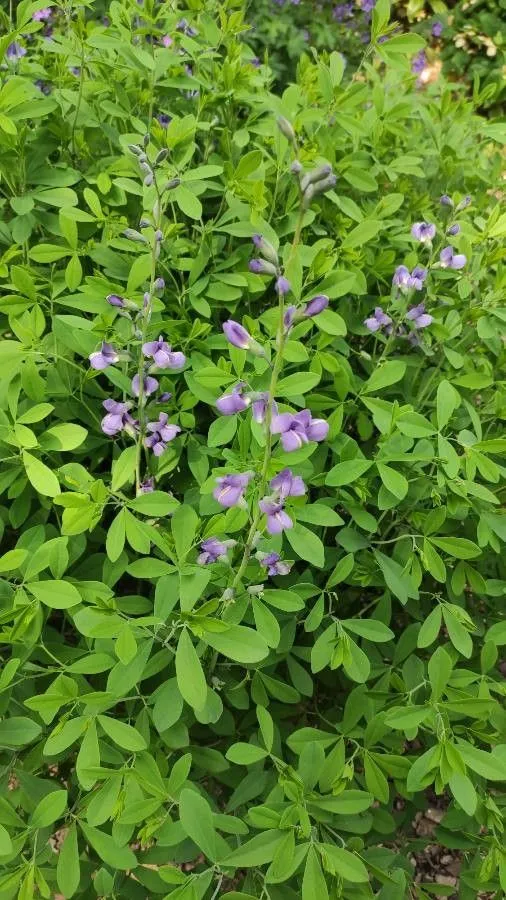
Author: (L.) R.Br.
Bibliography: W.T.Aiton, Hortus Kew. 3: 6 (1811)
Year: 1811
Status: accepted
Rank: species
Genus: Baptisia
Vegetable: False
Observations: WC. & E. U.S.A.
The Blue false indigo, scientifically known as Baptisia australis, is a member of the Fabaceae family. This perennial herb has long been admired for its striking appearance and robust nature, making it a popular choice among gardeners and plant enthusiasts.
Originating from the central and eastern regions of the United States, Blue false indigo thrives in well-drained soils and areas that receive ample sunlight. This hardiness has allowed it to become a staple in various landscapes, particularly in wildflower gardens and native plant restoration projects.
Baptisia australis is renowned for its tall, upright stature, which can reach up to 3 to 4 feet in height. One of its most notable features is its vibrant, indigo-blue flowers that bloom in late spring to early summer. These pealike blossoms are arranged in dense, terminal racemes that provide a dramatic splash of color against the plant’s blue-green foliage.
The foliage itself is another attractive aspect of the Blue false indigo. The leaves are trifoliate, meaning they are composed of three leaflets, and maintain a healthy blue-green hue throughout the growing season. In the fall, the plant can add interest to the garden with its striking black seed pods, which also make a unique addition to dried floral arrangements.
Baptisia australis is not only valued for its aesthetic appeal but also for its ecological benefits. It is a nitrogen-fixing plant, which means it has the ability to improve soil fertility by converting atmospheric nitrogen into a form that is usable by plants. This makes it an excellent companion plant in mixed gardens.
Moreover, Blue false indigo serves as a vital food source for various pollinators, including bees and butterflies, during its blooming period. Its resilience and low maintenance requirements make it an excellent choice for gardeners looking to add a touch of natural beauty to their outdoor spaces.
With its historical designation by W.T. Aiton in “Hortus Kew. 3: 6 (1811)” and its enduring popularity, Baptisia australis remains a captivating and valuable addition to any garden or natural setting.
Eng: baptisia, blue false indigo, blue wild indigo, streamside blue indigo, tall wild blue indigo, wild false indigo
Swe: färgväppling
Fra: baptisie bleue, baptisie australe
En: Blue False Indigo, Blue Wild Indigo, Baptisia, Streamside blue indigo, Tall wild blue indigo, Wild false indigo
Fr: Baptisie bleue, Baptisie australe
Sv: Färgväppling
: Blue wild indigo
Taken Jun 10, 2022 by L M (cc-by-sa)
Taken May 12, 2019 by Marsha Light (cc-by-sa)
Taken Jul 4, 2022 by Martina Lipperini (cc-by-sa)
Taken Jun 2, 2019 by Eddie Stegeman (cc-by-sa)
Taken Jun 5, 2021 by Sophia B (cc-by-sa)
Taken Jul 9, 2019 by Gen (cc-by-sa)
Taken Jul 12, 2021 by Mat (cc-by-sa)
Taken Aug 16, 2022 by huy HO (cc-by-sa)
Taken Aug 6, 2021 by Rutger P (cc-by-sa)
Taken Jul 19, 2021 by Alexander Becker (cc-by-sa)
Taken Aug 19, 2022 by S A (cc-by-sa)
Taken Jun 17, 2022 by olivier pasquet (cc-by-sa)
Taken Jun 28, 2022 by Christine Raffy (cc-by-sa)
Taken Jun 11, 2021 by Dieter Albrecht (cc-by-sa)
Taken Aug 6, 2021 by Rutger P (cc-by-sa)
Taken Jun 16, 2020 by Allan Meldrum (cc-by-sa)
Taken Jun 11, 2021 by Dieter Albrecht (cc-by-sa)
Taken Jun 15, 2020 by George Cantlie (cc-by-sa)
Taken Jun 10, 2022 by L M (cc-by-sa)
Taken May 8, 2020 by Elena Eigenher (cc-by-sa)
Taken Jul 6, 2022 by pflantastisch (cc-by-sa)
Taken Jun 25, 2022 by Dieter Albrecht (cc-by-sa)
Taken Jul 3, 2022 by Serge Klein (cc-by-sa)
Taken Sep 4, 2022 by Anne de Rivaz (cc-by-sa)
Taken Jun 11, 2021 by Dieter Albrecht (cc-by-sa)
© copyright of the Board of Trustees of the Royal Botanic Gardens, Kew.
© copyright of the Board of Trustees of the Royal Botanic Gardens, Kew.
© copyright of the Board of Trustees of the Royal Botanic Gardens, Kew.
Growth habit>: Forb/herb
Family: Myrtaceae Author: (F.Muell.) K.D.Hill & L.A.S.Johnson Bibliography: Telopea 6: 402 (1995) Year: 1995 Status:…
Family: Rubiaceae Author: Pierre ex A.Froehner Bibliography: Notizbl. Bot. Gart. Berlin-Dahlem 1: 237 (1897) Year:…
Family: Sapindaceae Author: Koidz. Bibliography: J. Coll. Sci. Imp. Univ. Tokyo 32(1): 38 (1911) Year:…
Family: Asteraceae Author: A.Gray Bibliography: Pacif. Railr. Rep.: 107 (1857) Year: 1857 Status: accepted Rank:…
Family: Fabaceae Author: Medik. Bibliography: Vorles. Churpfälz. Phys.-Ökon. Ges. 2: 398 (1787) Year: 1787 Status:…
Family: Aspleniaceae Author: (Cav.) Alston Bibliography: Bull. Misc. Inform. Kew 1932: 309 (1932) Year: 1932…